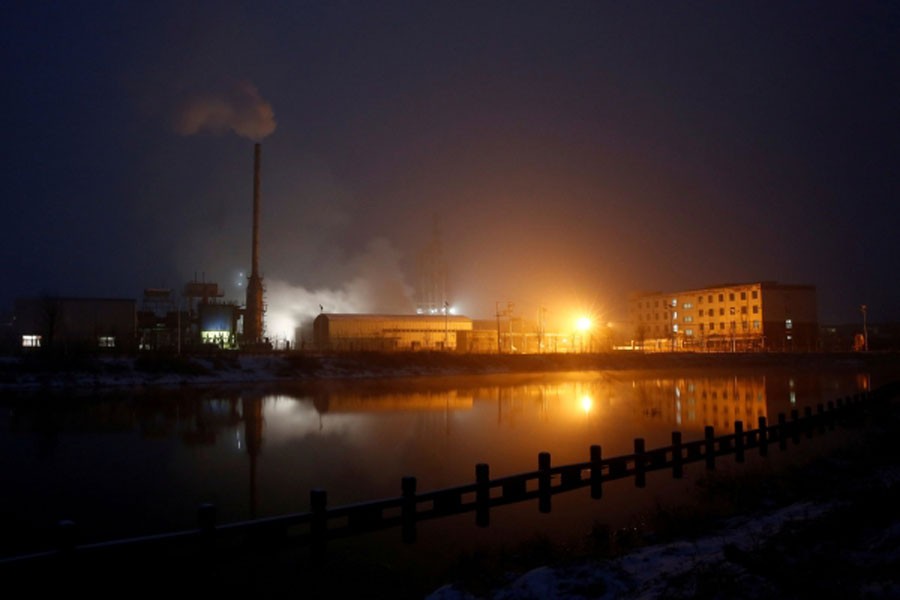Growth in China’s manufacturing sector slowed slightly in December as a punishing crackdown on air pollution and a cooling property market start to weigh on the world’s second-largest economy.
The data support the view that the economy is beginning to gradually lose steam after growing by a forecast-beating 6.9 per cent in the first nine months of the year, but the findings did not appear to suggest a risk of sharper slowdown at this point.
The official Purchasing Managers’ Index (PMI) released on Sunday dipped to 51.6 in December, down from 51.8 in November and in line with forecasts from economists in a Reuters poll.
But the overall reading still appeared relatively solid, and marked the 18th straight month that the sector has expanded. The 50-point level divides growth from contraction on a monthly basis.
The figures showed that China’s full-year 2017 economic growth would be at about 6.9 per cent and around 6.5 per cent for 2018, according to the China Federation of Logistics and Purchasing, which compiles the data. Both predictions would be slightly stronger than those in a Reuters poll.
“Overall, 2017’s economic performance continues to be steady and good, establishing a generally good foundation for 2018,” the federation said.
“Recent PMI surveys show companies are confident for economic development in the new year, with production and operating activity expectation indices showing significant improvement.”
On a Roll
Boosted by hefty government infrastructure spending, a resilient property market and unexpected strength in exports, China’s manufacturing and industrial firms have been a major driver behind solid economic growth this year, with their strong appetite for raw materials boosting global commodity prices.
However, a slowdown has started to take hold in the last few months due to a wide-ranging combination of government measures, from a crackdown on smog in heavily industrialised northern provinces to continued curbs on the housing market which are weighing on property investment.
Chinese steelmakers in 28 cities have been ordered to curb output between mid-November and mid-March, while a campaign to promote cleaner energy by converting coal to natural gas has also hampered manufacturing activity in some cities, leading to shortages and sending prices spiking.
Still, there are signs that steel mills, smelters and plants in parts of the country with fewer restrictions have ramped up production to win more market share, largely offsetting the “rustbelt” declines on a nation-wide basis.
A PMI sub-reading for production fell to 54 from 54.3 in November, but was bang in line with the average over the last six months.
Total new orders also dipped in December, to 53.4 from 53.6, but export orders grew at the fastest pace in six months, pointing to sustained strength in global demand heading into the new year and helping boost business optimism to the highest since September.
Chinese manufacturers continued to face stiff pressure from rising costs, however. A sub-index for input prices rose to 62.2 from 59.8 in November, while output price gains also picked up, which could pressure profit margins on companies further down the supply chain.
Tapping the brakes
Slowly rising borrowing costs due to a government crackdown on riskier lending practices are also expected to drag more prominently on economic activity in 2018.
The central bank nudged up interbank rates earlier this month for the fourth time this year, though policymakers are keen not to tap the brakes too sharply and risk a sharper economic slowdown.
Sources have told Reuters that Chinese leaders are likely to stick with a growth target of around 6.5 per cent for 2018, the same as in 2017, even as they continue efforts to defuse the risks from a rapid build-up of debt.
In a further sign of resilience, growth in China’s services sector, which was already robust, kicked up another notch in December, a sister survey showed.
The official non-manufacturing Purchasing Managers’ Index (PMI) rose to a three-month high of 55 from 54.8 in November.
And a reading on the construction sector rose to 63.9 from 61.4 in November, which was surprising given slowing property investment and the seasonal decline in building activity usually seen in colder months.
The services sector accounts for over half of China’s economy, with rising wages giving Chinese consumers more spending power.
China’s leaders are counting on growth in services and consumption to rebalance their economic growth model from its heavy reliance on investment and exports.


